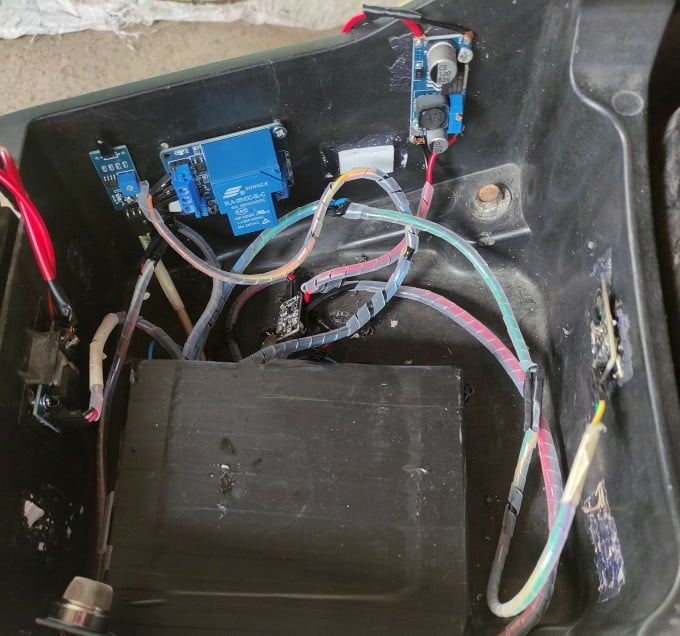The device designed by a group of students from Ho Chi Minh City University of Technical Education has a sensor that detects smoke and gasoline vapor, which helps send control signals and automatically start the fire extinguisher in case of emergency.
The anti-short circuit and anti-explosion product set for motorbikes was implemented by Tran Nhat Thanh Huy and Huynh Nguyen Anh Kiet, students of automotive engineering technology, international training faculty, from September 2023. The system includes sensors: smoke detection, current measurement, temperature, gasoline vapor detection, infrared, spark detection; relay module (main switch to cut off the power to the entire vehicle); alarm siren and automatic fire extinguisher. They operate based on Arduino board, will receive and transmit device control signals to protect the vehicle, automatically start the fire extinguisher in case of danger.
Thanh Huy, 22 years old, said that recently there have been many cases of fire and explosion due to electrical short circuits in motorbikes. The group of friends wanted to find a security system so that people could feel secure when parking their motorbikes in basements and parking lots when they could not actively observe.
The group bought some spare parts to research the anti-short circuit circuit and borrowed a scooter from the school workshop to do this project. After some research, the group designed the first version of the anti-short circuit circuit. But the initial short circuit protection circuit was very rudimentary, causing the actual experiment to fail. "The location near the battery was successful, but when we tried short circuiting at the lights and horn, the circuit did not cut off the power," Huy recalled, quite nervous and afraid of burning the vehicle.

The device is installed in the test vehicle. Photo: NVCC
After many trials without progress, the group shared their ideas and the teacher suggested that they should program the sensors. From there, the group designed an automatic programming circuit including an Arduino control circuit, a smoke sensor and an on/off relay. Then other components were added and upgraded to the circuit including sensors: temperature, fire, gasoline vapor, especially an automatic fire extinguisher that the group made from a mini fire extinguisher and an electric motor.
Huy said the most memorable part was the assembly process. When starting the second experiment, the group discovered that the school's motorbike was too old and wouldn't start, so they had to find another one. "No one wanted to lend us their motorbikes because they were afraid of breaking them, so I used my dad's old scooter for the experiment," Huy said. During the experiment, because the motorbike was still used for commuting, the group would take apart the parts every day to return the motorbike.
The most difficult thing was that at first I didn't know how to arrange the wires, so I had to remove the entire circuit and reattach each part many times. After many tests and studying the indicators, the system finally worked smoothly.
According to the group, the project still has some unfinished points such as using too many wires leading to tangles, not solving the problem of maintaining the power source long enough, because the system uses power directly from the battery so the battery can run out. Currently, the group continues to improve the model with wireless sensors attached to image processing cameras to scan the surroundings to detect nearby vehicles on fire. "Electric vehicles are developing very strongly, we really hope to be able to upgrade the system to apply to electric vehicles," Huy said.
A group of students tested situations to prevent short circuits and explosions in motorbikes. Video : NVCC
Associate Professor Dr. Do Van Dung, former Principal of Ho Chi Minh City University of Technical Education and Vice President of the Automobile and Engine Association, assessed the project idea as practical and feasible. He said that the main cause of motorcycle fires is electrical short circuits. Motorcycle electrical systems use power from batteries and are protected by fuses, but there are two circuits that do not go through fuses: the charging circuit and the starter circuit. This can easily cause fires and explosions because the electrical system uses a common wire, the frame of the vehicle, connected to the negative pole of the battery. In hot and humid weather conditions, the electrical wires are easily aged, leading to peeling and damage, causing short circuits and fires. The electrical wires can run through the fuel lines, and a small electrical problem can lead to a fuel line fire, causing a vehicle fire.
By using early detection sensors such as heat, smoke, gasoline vapor, spark sensors, the system will immediately cut off the power supply from the battery when a short circuit occurs at any location to minimize the risk of fire or explosion. In case of fire, the system will receive and send a signal to control the mini fire extinguisher to extinguish the fire.
Although many aspects still need to be considered, Associate Professor Dung assessed that the Arduino system is designed to be quite compact, easy to install in the car without causing any problems for the user, and if produced, it would only cost about 400-500 thousand VND, relatively cheap, suitable for consumers.
Nhu Quynh
Source link









































































































Comment (0)